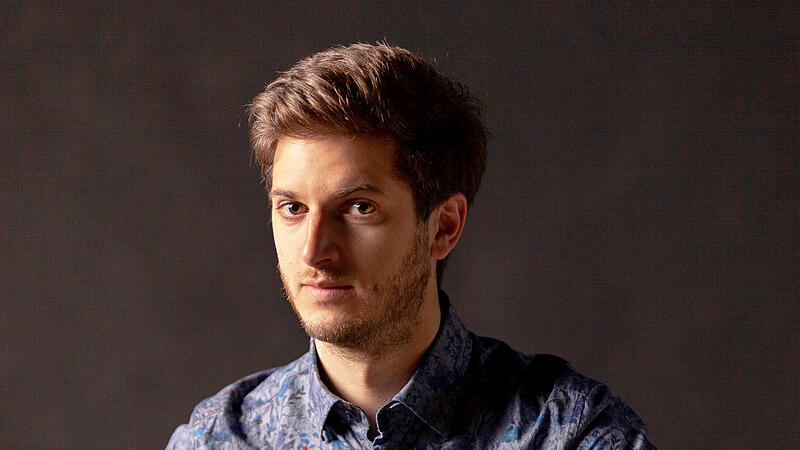Image: Maria Otter
The only thing that didn’t exist back then was the small floor lamp. The keys that Alexander Gergelyfi touched in her light in Admont Abbey are the same as they were around 1700. They belong to the “Admonter Clavichord”, which the Linz-born Steyrer bought two years ago. And on which he recorded his first solo CD “Sapperlot!”, in the small ballroom of the monastery late at night, usually until shortly before midnight. “Everything in the pen calms down and comes to an inner peace. That’s when it’s best to play the clavichord,” he recalls of those unforgettable four nights.
“Sapperlot, much work” was his CD, which was released in November, his sigh has flowed into the title, also because “the word describes Austria well”, since all the recorded works from the 16th to 18th centuries come from Austrian sources. The longest piece is the twelve-minute passacaglia by Georg Muffat (1653-1704), “for this you need almost all the keys, the entire range” of four octaves available on the clavichord. “That’s the greatest thing you can play on the instrument.” He got as far as Mozart, a third of the works are first performances.
Bach never heard an airplane
For two years he has called the Admonter clavichord his own. A couple of musician friends from Graz offered him the restored treasure: artistically painted, the lid of the instrument shows the Benedictine monastery, the Frauenberg church, the Enns river and the Gesäuse – an indication of the age of the instrument, “between 1690 and 1702, because it shows individual stages of construction that did not exist before and after,” says the 35-year-old, who studied historical keyboard instruments and their performance practice as a music high school student at the Bruckner University in Linz and then in Hamburg and Graz. He has been teaching at the Music University in Graz since 2017.
The clavichord was also mostly intended for study, especially for organists. “It was used for composing and as a travel instrument. A harpsichord was far too expensive. You can build clavichords relatively cheaply,” says Gergelyfi, who owes his name to Hungarian ancestors.
The way of playing allows what is not possible on other keyboard instruments: to modulate the sound similar to the vibrato on a violin. “We call it beating. At the end of the key is a tangent, a sheet of iron or brass that presses against the string and performs the function of a fret, bridge, or finger on the stringed instrument. As long as you hold the key, the tone sounds. With more attack I can play louder, and if I bring the string more out of the resting position, it becomes higher, you can intonate. This is unique and not possible on any other instrument. There are so many colors and it’s definitely the most intimate instrument, with a rather quiet sound that wasn’t intended for concerts in large halls, but more “for the chamber at home”. But: “Within the spectrum of the instrument you can very well play pianissimo or fortissimo”, he warns against comparisons with our listening habits today. “Bach never heard a plane take off either.”
Concerto on five instruments
In the Brucknerhaus, however, not only his Admonter clavichord can be heard, but also a virginal from northern Italy around 1600, two harpsichords from around 1710 and a pianoforte from Florence from 1726 – “five structurally very different instruments, on each of which I play works that are suitable for this fit particularly well. The audience can hear what’s changing”, whereby he will be hitting the keys on stage, but also in the auditorium. “The instruments were used for entertainment in pubs, in restaurants, at the barber’s, they played it like radio. They are not built for the stage, for far away and distance.”
After starting out on the keyboard at the Garsten State Music School, how did he come to study historical keyboard instruments? “I really annoyed my professor back then because I only ever played much older music – Bach, Haydn, Mozart,” he recalls of his time at the Bruckner University in Linz. During a summer course he discovered the realm of historical keyboard instruments through August Humer. “I was actually with him all week.”
What appeals to him is “the haptic experience” on harpsichord, fortepiano, virginal and clavichord. But also the freedom in early music: “What is written down is only a guide. The music actually comes from improvisation and was then notated more and more concretely and precisely. With the construction of the conservatories, many things have become stricter.”
Anyone who would like to learn historical keyboard instruments today has the opportunity, for example, at the music school in Linz, where harpsichord lessons are offered. “It’s much more normal in France, you often start on viola da gamba, harpsichord. With us it’s more like violin, piano, recorder,” says Gergelyfi. The old instruments are also built again, mostly “according to historical models as closely as possible”. Musical instruments are always built in certain proportions. The instrument maker I trust is in Berlin, he is currently building a harpsichord for me.” How many old instruments are still preserved? Gergelyfi estimates the number of historical harpsichords at “a few hundred worldwide”. “It’s actually not much. At that time there were ten workshops in parallel in Paris, and Hamburg and Antwerp were also centers for keyboard instruments.”
He finds the literature in historical prints. “But I prefer to look up the forewords and see where something is. I almost never play anything that I haven’t checked the handwriting myself. The publisher also makes a decision – it often has to do with the music writing program and not with the music.” Which is why his path often leads him behind venerable monastery walls. “There’s so much music that hasn’t been lifted.”
Alexander Gergelyfi, master of historical keyboard instruments
more from culture
Inntones: The festival on the farm
Bruckneruni: Excitement at the Drama Institute
Springer-Verlag exchanges editor-in-chief at “Bild”.
Intimate instead of cool: U2 cores 40 songs
: Nachrichten

I am an author and journalist who has worked in the entertainment industry for over a decade. I currently work as a news editor at a major news website, and my focus is on covering the latest trends in entertainment. I also write occasional pieces for other outlets, and have authored two books about the entertainment industry.
I am an author and journalist who has worked in the entertainment industry for over a decade. I currently work as a news editor at a major news website, and my focus is on covering the latest trends in entertainment. I also write occasional pieces for other outlets, and have authored two books about the entertainment industry.




